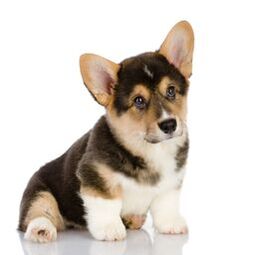As a veterinarian, I am often asked by new puppy owners when they can start training their pups. Some trainers are still recommending that you wait until the puppy is 6 months old. To me, this means 4 months of missed opportunity and the creation of bad habits. I believe puppy training should start the day they come home with you. You would be amazed at what an 8 week old puppy can do.
Puppy training activities require many small treats, about the size of a pea. Soft treats are best, so that the pup doesn’t spend too much time chewing and can focus more on what you are trying to teach. Basic dog treats like Zukes minis are fine to use at home, but “high value rewards” like chicken, hot dogs, liver, etc. are needed if you are in a distracting environment, like dog shows and classes.

Here are a few puppy lessons that I have acquired from a variety of trainers.
Voluntary Attention: If your dog acts like you don’t exist, it is pretty hard to train him. When your dog learns to pay attention to you, the rest of your training becomes easier.
Start this exercise by sitting in a chair while holding your puppy on a leash. Do not talk to him or try to get him to do anything. When he glances in your direction, give him a treat. If he does not look at you in the first few minutes, show him a treat. When he looks at the treat, bring it toward your face so that he is looking at your face before you give it to him. Each time he looks at you, give him a treat. Pretty soon, he will be sitting and staring at you. You can then wait longer intervals before you treat, but don’t make it too hard, too fast.
Once your puppy can readily focus on you, you can hold a treat in your hand out to the side, up away from the pup. He will probably look at it, but he should soon glance back at your face. Treat when he looks at you. Do this for 10-15 minutes a couple of times a week. When he gets good at it, try it in a more distracting environment, like a park. If you are taking puppy classes, this is a great exercise to do when the instructor is talking and the pup is not doing anything else.
Zen puppy: Hold a treat in your hand and show it to your pup. Then close your hand around it loosely. The average puppy will sniff, paw or push at your hand. Do not let him get the treat. When he stops trying to get the treat, open your hand and say, “Take.” At first, all you are looking for is the puppy to look away or back away. When he starts to understand the concept of “I can’t just grab what I want,” you may choose to wait for a polite behavior, such as a sit. When he is getting good at this, you can try the same exercise with the treat on the coffee table. Make sure you keep him from taking it himself. He only gets the treat when he leaves it alone.

This is an exercise in self-control. It is a basic skill that will keep your dog from grabbing cookies out of the hands of toddlers, counter surfing for food, and similar undesirable behaviors. Dogs get what they want when you decide they can have it.
Feeding Games: At meal time, give your puppy only ¼ of his food. When he is almost done with that portion, toss another handful in his bowl. Continue in this manner until he gets his whole dinner. Every so often, you can toss in a small, yummy treat. If you have kids in your house, let them play this game with the puppy as well. Play this game at least once daily.
This simple exercise teaches your puppy that it is ok for people to be near him when he is eating. Good things happen when human hands come near his bowl. It will keep him from ever being protective of his food bowl.
Let’s trade: Give your puppy something he will really like, such as a bully stick. When he starts to chew on it, toss a high value reward about a foot away where he can see it. When he stops chewing to take the treat, pick up the bully stick. When he is done with the treat, give him his stick back. Do this several times in a row, so that he realizes he gets a treat when he stops chewing and then gets to chew some more. Win-win! As he starts to get this concept, attach a word such as “give” as you toss the treat. You can soon work toward offering him the treat from your hand, and eventually reaching for the stick as you offer him the treat. Remember to keep giving him the stick back. Soon you will be able to just say, “Give” without the treat, but I believe in intermittently treating dogs throughout their lifetimes. Good things happen when you do what you are told.
This game will be helpful when your dog picks up something he should not have, whether it is a chicken bone he found in the street or someone’s shoe that looks a lot like a toy to a puppy.
Recall games: This game takes two or more humans and one puppy to play. You can do it in a hallway or a large open room. Each person has a bag of treats and sits several feet from the others. One person starts with the puppy. The other calls the puppy by name in a very excited manner. Puppy, puppy, puppy! Yay! Puppy gets treats from that person, and the next person calls him right after he finishes them. Play for only a few minutes so he doesn’t get bored or distracted.
This can be extended to the outside as well. When the puppy is playing or sniffing, call him in your most enthusiastic voice. Treat him and let him go back to play. Coming to you should not mean that all the fun is about to end.
I do not use my “formal” recall command for this. (Mine is, “Come front.”) I reserve my formal command for later training. I don’t want him to learn to ever ignore the formal command (“poisoning” the command), and I am not ready to give corrections this early in his training career. I only use the puppy’s name to call him in this game.
Ring the bell: During housebreaking, there always comes a time when the puppy starts to “get it” and you start to trust him more. You pay a little less attention to where he is. He needs to pee and goes to the door. But no one knows he is there and he does not know what to do next. So he pees on the floor right there. Some people will teach their dog to bark by the door, but I really do not like to reward barking.
I use wind chimes on my back door. Some people use Christmas jingle bells. Every time you let your dog out, say, “Ring the bell.” Since we are starting with an 8 week old, you will be holding the pup in your hands. Push his nose into the bells. “Good boy! Let’s go out.” If you do this every time you take your puppy out, he will learn very quickly to ring the bell on his own. (One of my dogs had it down at 10 weeks.)
Why is this helpful? Now, that pup that goes to the door and wants to go out knows how to get your attention. I can hear my bells from anywhere in the house. (I can also tell who is ringing, as they all do it a bit differently.) So no more puddles at the door. I bring my bells when I travel, so my dogs know which door they need to go out, and they can even let me know they need to go when they are in a hotel room.
The warning that comes with this trick is that the pup is telling you he wants to go out, not that he needs to pee. You need to accept this and let him out every time he rings so that he gets the connection between the bell and going out.
Touching games: It is a good idea to get your puppy used to having you in their personal spaces. These include their feet, rear end, mouth and ears. This will make your life easier when it comes to grooming, nail trimming, teeth brushing, etc. Use lots of treats. Touch your puppy’s foot and give a treat. Put your finger in his ears, then treat him. Eventually advance to holding your pup’s paw. Work your way up to lifting up his lips and pulling back his lips to look at his back teeth. Rub your finger on his teeth to simulate brushing them. Remember lots of praise, lots of treats and don’t push things too quickly. Run a comb over him, too, and give treats. Soon touching should be no big deal to him. Have other people touch him in these ways, as well, so that a groomer or vet is not so scary.
Four on the floor: Most people dislike having a dog jump on them. Puppies are very enthusiastic and don’t know better. They need to learn early, before this becomes a bad habit.
The basic concept here that the pup is to learn is that he gets attention when he doesn’t jump on you. If the pup is coming toward you excitedly, try to bend over and pet him before he starts to jump. Use lots of praise in a calm, happy voice. If he already jumped on you, or he jumps when you stop petting him, stand up straight and ignore him. You can turn your back on him as well. When he stops jumping, reach down and pet him again. It will take many months of being consistent for the pup to learn this form of self-control.
Basic commands: 8 weeks is not too early to start to train sit, stay, down, and walk nicely on a leash. Lessons should be very short at first: two or three minutes at a time. And, of course, lots of treats should be used.
Puppy training should be a part of your new puppy’s everyday life. He will quickly learn that good behavior gets rewarded. Remember to make these lessons fun for your puppy and they will then be fun for you as well. Happy training!

